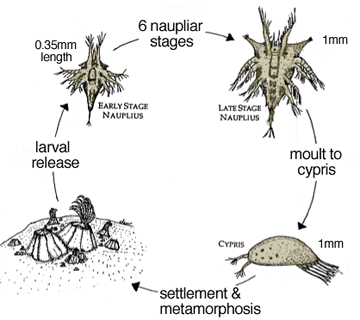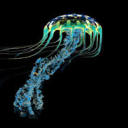Pyrocystis Fusiformis Is a Common Plankton That Produces Bioluminescence. Not Exactly A Marine Animal,
Pyrocystis fusiformis is a common plankton that produces bioluminescence. Not exactly a marine animal, but an amazing organism that produces bioluminescence. So, I thought it was worth sharing on this page.



Pyrocystis fusiformis
Pyrocystis Fusiformis is a marine dinoflagellate that is non-motile and has a short life cycle (5-7 days). When disturbed, the dinoflagellate displays vibrant, blue bioluminescence. The bioluminescence is design to startle grazers, or cause them to glow, making them more vulnerable to predators. During the day, it uses photosynthesis to produce its own food, and it produce bioluminescence at night. Furthermore, it fixes carbon from the ocean and produces oxygen for the marine animals that live there. All in all, I find this diamond shaped plankton to be unique and beautiful.
Photo credit: https://fineartamerica.com/featured/2-bioluminescence-of-pyrocystis-fusiformis-gerd-guentherscience-photo-library.html
https://exploringtheinvisible.com/2013/11/21/c-mould-new-acquisition-pyrocystis-fusiformis/
https://www.flickr.com/photos/13084997@N03/32823053106
More Posts from Bioluminescentoceangoddess and Others



Black Dragonfish
Idiacanthus atlanticus
The Black Dragonfish are needle-like fish that migrate between 500m and 2000m in the deep ocean. Females are black with 6 stripes and lack a barbel, pelvic fins, and sharp teeth. Males, on the other hand, are dark brown and have a barbel, which is the light producing structure on its chin. Furthermore, it uses bioluminescence to detect prey instead of lure prey.
Photo credit: https://scitechdaily.com/scientists-learn-secrets-from-ultra-black-skin-that-allows-deep-sea-fish-to-lurk-unseen/
https://steemit.com/life/@munnashah/the-most-terrible-and-surprising-7-animals-of-the-sea
https://knowyourmeme.com/photos/995601-thalassophobia


Giant Bell Jelly
Scrippsia pacifica
The Giant Belly Jelly has 256 tentacles attached to a gelatinous bell-shaped base. Like most cnidarians, the Giant Belly Jelly uses specialized stinging cells called nematocysts to catch its prey. When fish and other prey swim into its tentacles, the sensory projection on the cnidocyte (cell that holds the nematocysts) is activated. Then the nematocysts and barb are released, hitting the vulnerable prey and releasing a toxin into the prey’s body. The Giant Bell Jelly is found at 400 m in the ocean. It is related to the jellyfish, but it is categorized as a Hydrozoa (similar to the Portuguese- man-o-war)
https://vimeo.com/42551565
Photo Credit: https://www.pinterest.cl/pin/467107792572034837/
https://courses.lumenlearning.com/ivytech-bio1-1/chapter/phylum-cnidaria/

Threadfin Snailfish
Careproctus longifilis
The Threadfin Snailfish resembles a prehistoric tadpole that is ghostly white. The holes in its face are large sensory pores that help them detect changes in the ocean. It is often found at depths between 1900 to 2997 meters.
Photo credit: https://www.timeout.com/singapore/museums/creatures-of-the-deep


Wolftrap Angler
Thaumatichthys binghami
The Wolftrap Angler is slightly different from many other species of anglers. It has its bioluminescent lure located inside of its mouth instead of connected to its body. Even though it is intimidating up close, it is only nine centimeters in size. It is found in the deep ocean at 2432m.
Photo credit
https://en.wikipedia.org/wiki/Thaumatichthys_binghami
https://igniteyourcuriosity.wordpress.com/2016/10/22/anglerfish/
If you are interested in learning about different types of plankton in the ocean, please check out @planktonqueen page. I post a lot of cool species, photos, and facts.


Barnacle Larvae
Amphibalanus eburneus
When we think of barnacles, we think of the hard, white crustaceans that grow on the side of boats and docks. However, barnacles go through a variety life stages and metamorphosis before they spend their life on a hard surface. The image above is a barnacle larvae when it is in the cypris stage, think of it as a baby barnacle. This larvae is an example of zooplankton and spends a short period of time floating around in the water column. The second image summarizes the life cycle of a barnacle.
Photo source: https://www.nyharbornature.com/blog/barnacles-are-reproducing
https://www.pinterest.com/pin/453174781229895797/

Pram Bug
Phronima sedentaria
The Pram Bug is a deep sea amphipod that is located between 200 to 1000m in the ocean. It has a translucent exoskeleton and can see primarily blue light. It is also is contained in a hollowed out barrel that is used for protection and to house babies. The image above is a female pram bug carrying its young.
Photo Credit:https://ocean.si.edu/ocean-life/invertebrates/phronima-female-and-young


Physonect Siphonophore
Nanomia cara
The Physonect siphonophore has tiny, bubble shaped sacs that are filled with gas. The sacs are called pneumatophores and help this creature move through the deep ocean. It also has venomous tentacles that stun prey and over eighty stomachs. There are numerous amounts of these strange creatures along the east coast, and they have cause some fisheries to collapse. Furthermore, they can be found at depth between 400m to 1000m.
Photo credit: http://www.seawater.no/fauna/cnidaria/cara.html
https://www.mindenpictures.com/stock-photo-siphonophore-hydrozoan-cnidarian-nanomia-cara-atlantic-nectophores-naturephotography-image90194961.html


Lav Polyp
leuckartiara octona
The Lav Polypo is a jelly that comes in a variety of colors and shapes; it dwells about 200m in the deep ocean. The red mass inside its translucent bell is the jelly’s reproductive organs. Furthermore, it uses its dull, yellow tentacles can catch unsuspecting prey.
Photo credit: https://www.pinterest.com/pin/65935582019848580/
https://www.petjellyfish.co.uk/shop/live-jellyfish/leuckartiara-octona


Cockatoo Squid
Galiteuthis phyllura
The Cockatoo squid is a highly-specialized oddity of the deep ocean and found at depths between 300 to 1400 m. It is completely transparent, except for its eyes. It also has bioluminescent photophores that are directed downward: this makes it difficult for deep sea predators to see the Cockatoo Squid. It was named after the Cockatoo because it holds its tentacles above its head, resembling the bird. The Cockatoo squid can also get fairly large with adults reaching lengths of 2.7 meters (over 6 ft.)
Photocredit: https://www.americanscientist.org/article/at-home-in-the-dark
https://www.pinterest.com/pin/28710516347382519/

Vampire Squid
Vampyroteuthis infernalis
Even though the Vampire Squid is named after a notorious monster, this gentle creature does not live up to its name. It is only a foot long and occupies depths between 650m to 1500m in the deep ocean. Unlike other squids, it has reduced musculature and collects particles in the water column. However, it is capable of huge bursts of speeds. It uses bioluminescence to confuse both predators.
Photo credit: https://ocean.si.edu/ocean-life/invertebrates/vampire-squid-hell
-
 mycellpics liked this · 1 year ago
mycellpics liked this · 1 year ago -
 maxinji liked this · 2 years ago
maxinji liked this · 2 years ago -
 mawsteeth liked this · 2 years ago
mawsteeth liked this · 2 years ago -
 beforestormbreaks reblogged this · 2 years ago
beforestormbreaks reblogged this · 2 years ago -
 beforestormbreaks liked this · 2 years ago
beforestormbreaks liked this · 2 years ago -
 angrymilkshakepeace liked this · 2 years ago
angrymilkshakepeace liked this · 2 years ago -
 hmmmmho liked this · 3 years ago
hmmmmho liked this · 3 years ago -
 lily-ily-ly liked this · 3 years ago
lily-ily-ly liked this · 3 years ago -
 aganatis liked this · 3 years ago
aganatis liked this · 3 years ago -
 astrotracksuitbattalion liked this · 3 years ago
astrotracksuitbattalion liked this · 3 years ago -
 acolorcollective liked this · 3 years ago
acolorcollective liked this · 3 years ago -
 rustedskyprisms liked this · 3 years ago
rustedskyprisms liked this · 3 years ago -
 808beat reblogged this · 3 years ago
808beat reblogged this · 3 years ago -
 despair-with-walnuts liked this · 3 years ago
despair-with-walnuts liked this · 3 years ago -
 808beat liked this · 3 years ago
808beat liked this · 3 years ago -
 theguyontheleft liked this · 3 years ago
theguyontheleft liked this · 3 years ago -
 windyboysworld liked this · 3 years ago
windyboysworld liked this · 3 years ago -
 agent-plaguemask reblogged this · 3 years ago
agent-plaguemask reblogged this · 3 years ago -
 creaturedeityendless liked this · 3 years ago
creaturedeityendless liked this · 3 years ago -
 deadlygoldfish22 liked this · 3 years ago
deadlygoldfish22 liked this · 3 years ago -
 wisent15 liked this · 3 years ago
wisent15 liked this · 3 years ago -
 wisent15 reblogged this · 3 years ago
wisent15 reblogged this · 3 years ago -
 nossalaguna liked this · 3 years ago
nossalaguna liked this · 3 years ago -
 ash-the-nekogirl reblogged this · 3 years ago
ash-the-nekogirl reblogged this · 3 years ago -
 ash-the-nekogirl liked this · 3 years ago
ash-the-nekogirl liked this · 3 years ago -
 securechained reblogged this · 3 years ago
securechained reblogged this · 3 years ago -
 iglow-pink liked this · 3 years ago
iglow-pink liked this · 3 years ago -
 goliatheshead reblogged this · 3 years ago
goliatheshead reblogged this · 3 years ago -
 goliatheshead liked this · 3 years ago
goliatheshead liked this · 3 years ago -
 salvagethevixin liked this · 3 years ago
salvagethevixin liked this · 3 years ago -
 rugletthewren liked this · 3 years ago
rugletthewren liked this · 3 years ago -
 texas-toadhouse liked this · 3 years ago
texas-toadhouse liked this · 3 years ago -
 gabz98 liked this · 3 years ago
gabz98 liked this · 3 years ago -
 brines liked this · 3 years ago
brines liked this · 3 years ago -
 planetaerium reblogged this · 3 years ago
planetaerium reblogged this · 3 years ago -
 gallopingsight reblogged this · 3 years ago
gallopingsight reblogged this · 3 years ago -
 planetaerium liked this · 3 years ago
planetaerium liked this · 3 years ago -
 wunkei liked this · 3 years ago
wunkei liked this · 3 years ago -
 nulno liked this · 3 years ago
nulno liked this · 3 years ago -
 saturnmortis reblogged this · 4 years ago
saturnmortis reblogged this · 4 years ago -
 saturnmortis liked this · 4 years ago
saturnmortis liked this · 4 years ago -
 czmairotciv liked this · 4 years ago
czmairotciv liked this · 4 years ago -
 13-betelgeuse-0 liked this · 4 years ago
13-betelgeuse-0 liked this · 4 years ago -
 nope-astrology-nope reblogged this · 4 years ago
nope-astrology-nope reblogged this · 4 years ago

Bioluminescence is a chemical reaction that produces light. Many deep sea animals use bioluminescence. This blog is dedicated to educating the public about the amazing creatures that thrive in the deep sea.
57 posts